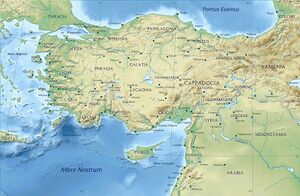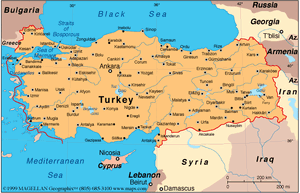Niksar
| Author:Laxman Burdak, IFS (R) |


Niksar, historically known as Neocaesarea (Νεοκαισάρεια), is a city in Tokat Province, Turkey. Niksar is known as "Çukurova of the North-Anatolia" due to its production of many kinds of fruits and vegetables except citrus fruits.It has always been an important place in Anatolia because of its location, climate and productive farmland.
Variants
- Neocaesarea (Νεοκαισάρεια)
- Cabira (Κάβειρα in Greek)
- Neocæsarea (Pliny.vi.3)
- Diospolis
- Sebaste
- Neokaisareia
Jat clans
Jat Gotras Namesake
- Kabiri = Cabira = *Neocæsarea (Pliny.vi.3)
History
Niksar has been ruled by the Hittite, Persian, Greek, Pontic, Roman, Byzantine, Danishmend, Seljuk and Ottoman Empires.
It was known as Cabira in the Hellenistic period (Κάβειρα in Greek). It was one of the favourite residences of Mithridates the Great, who built a palace there, and later of King Polemon I and his successors.[1]
In 72 or 71 BCE, the Battle of Cabira during the Third Mithridatic War took place at Cabira, and the city passed to the Romans. Niksar was called Diospolis, Sebaste, and Neokaisareia during the Roman period. Pompey made it a city and gave it the name of Diopolis, while Pythodoris, widow of Polemon, made it her capital and called it Sebaste. It is not known precisely when it assumed the name of Neocaesarea, mentioned for the first time in Pliny, "Hist. Nat.", VI, III, 1, but judging from its coins, one might suppose that it was during the reign of Tiberius.[2] In 344 the city was completely destroyed by an earthquake[3] Neocaesarea became part of the Eastern Roman Empire when the Roman Empire divided into two parts in AD 395. Another earthquake occurred in 499, the 499 Nicopolis earthquake.[4]
During the Middle Ages, the Muslims and Christians disputed the possession of Neocaesarea, and in 1068 a Seljuk general, Melik-Ghazi, whose tomb is still visible, captured and pillaged it. When the Seljuqs raided Anatolia in 1067, Neocaesarea was conquered by Afşın Bey, one of the commanders of Alp Arslan. The Byzantines retook the area in 1068. Conquered by Artuk Bey after the Battle of Manzikert, Neocæsarea once again returned to Byzantium in 1073. The city became part of the domain of Roussel de Bailleul, a Norman mercenary who had rebelled against the Byzantine empire, and who held the town until 1075.[5] Melik Gümüştekin Ahmet Gazi (better known as Danishmend Gazi), founder of the Danishmend, was the next conqueror of Neocaesarea. After the conquest the Gazi made it his capital city, and, under the name Niksar, became a center of science and culture. The Danishmend Gazi's mausoleum stands in a large cemetery just outside the town.
By 1175, during the reign of Kılıç Arslan II, Niksar was dependent on the Seljuks of Rum. After the Mongol invasion of the 13th century, Niksar was governed by the Eretnids and then the Beylik of Tacettin, a beylik and became the center of the latter principality. After Kadı Burhanettin (who conquered Niksar in 1387) was killed in battle, the people of Niksar sought aid from the Ottoman Sultan Bayezid I. The Sultan's son, Süleyman Çelebi, took Niksar for the Ottomans. In the later Ottoman period, Niksar became part of Tokat Province. Fatih Mehmet launched a raid on Trabzon from Niksar, and Selim I and Suleiman the Magnificent raided the east from there. The town was predominantly Muslim in the mid 17th century.[6]
Mention by Pliny
Pliny[7] mentions...Cappadocia1 has in the interior Archelais,2 a colony founded by Claudius Cæsar, and past which the river Halys flows; also the towns of Comana,3 watered by the Sarus, Neocæsarea,4 by the Lycus,5 and Amasia,6 in the region of Gazacene, washed by the Iris. In Colopene it has Sebastia and Sebastopolis;7 these are insignificant places, but still equal in importance to those just mentioned.
1 The boundaries of Cappadocia varied under the dominion of the Persians, after the Macedonian conquest, and as a Roman province under the emperors.
2 Founded by Archelaüs, the last king of Cappadocia. In Hamilton's Researches, the site has been assumed to be the modern Ak-serai, but that place is not on the river Halys, as Leake supposes. It is, however, considered that Ak-serai agrees very well with the position of Archelais as laid down in the Itineraries, and that Pliny may have been misled in supposing that the stream on which it stood was the Halys.
3 Also called by the name of Chryse, or "Golden," to distinguish it from another place of the same name in Pontus. It is generally supposed that the town of Al-Bostan, on the Sihoon or Sarus, is on or near the site of this Comana.
4 Now called Niksar, according to D'Anville, though Hardouin says that it is Tocat. Parisot remarks, that this place belonged rather to Pontus than to Cappadocia.
5 A small tributary of the Iris, or Yeshil-Irmak, mentioned in the next Chapter.
6 Both to the west of Neo-Cæsarea. According to Tavernier, as quoted by Hardouin, the modern name of Sebastia is Sivas.
7 Still called Amasia, or Amasiyeh, and situate on the river Iris, or Yeshil Ermak. It was at one time the residence of the princes of Pontus, and the birth-place of the geographer Strabo. The remains of antiquity here are very considerable, and extremely interesting.
References
- ↑ Catholic Encyclopedia, 1907, s.v. Neocaesarea
- ↑ Catholic Encyclopedia, 1907, s.v. Neocaesarea
- ↑ Jerome, Chronicle, anno 2362
- ↑ Theodorus Lector, II, 54
- ↑ Beihammer 2017, pp. 210–212.
- ↑ Sinclair, T.A. (1989). Eastern Turkey: An Architectural & Archaeological Survey, Volume I. Pindar Press. p. 389. ISBN 9780907132325.
- ↑ Natural History by Pliny Book VI/Chapter 3
Back to Jat Places in Turkey

